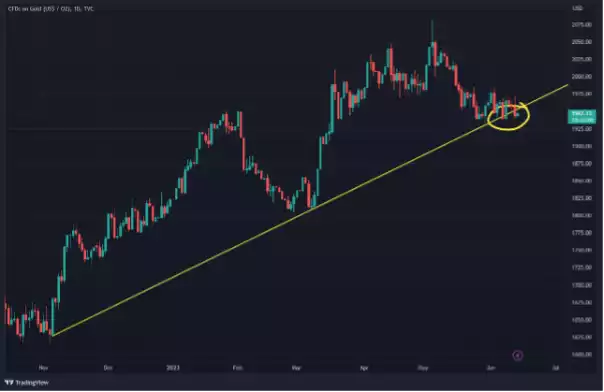Good CPI? Why Did Central Banks Buy?
News
|
Posted 15/06/2023
|
9111
The US CPI rose 0.1% last month after rising 0.4% in April, and core inflation remained unchanged at 0.4%. Major US indices all made further gains and it looks as though a rate pause is all but priced in. Looking at the Gold/USD chart below, it’s evident that gold has been on a rising trend line since November last year but has had a breakdown in the last 5 days, which can be a signal for a sell or sideways price action. In the short term, it seems risk markets are strong, and traders are looking toward the FOMC for confirmation. But before scrutinising too closely what central banks like the Fed say, it could be worth looking at what they have done.

Remember the global central bank gold-buying spree? Central banks have bought at a record pace in the first two months of 2023, according to a report by the World Gold Council. They bought a net 125 tonnes of gold during January- February, marking the highest amount for the year-to-date period since the banks became net-buyers in 2010. This challenges the narrative that a few interest rate hikes will completely fix the current debt-based monetary system.
Leading the purchases in the first two months were Singapore at 51.4 tonnes, Turkey at 45.5 tonnes, China at 39.8 tonnes, Russia at 31.1 tonnes, and India buying 2.8 tonnes. The Central Bank of Russia, which hadn't published an update on its gold reserves for about a year, may have accumulated the 31.1 tonnes over several months rather than in the specified period.
On the other hand, only a few central banks reduced their gold reserves during this period: Kazakhstan, Uzbekistan, Croatia, and the United Arab Emirates (UAE). However, the overall purchases throughout the year surpassed the sales by a significant margin.
The BRICS countries (Brazil, Russia, India, China, and South Africa) have emerged as some of the biggest buyers, reflecting a shift of global power. These countries' combined share of the global economy has now exceeded that of the G7 nations. Gold plays a crucial role in this process as the BRICS seek to support their currencies and reduce their reliance on the U.S. dollar, which has been the global reserve currency for about a century. As more global trade is conducted in Chinese yuan, the BRICS, and potentially other emerging economies like Saudi Arabia and Iran, are developing alternative payment systems.
What if the Fed pauses rate hikes?
“If the Fed was looking for data to point to say, 'We're going to pause in June,' I think they got it today," said Liz Young, head of investment strategy at SoFi in New York - Reuters. Historically, when the Federal Reserve pauses its rate hikes, a recession follows 75% of the time roughly 6 months later. If you dig deeper into this statistic, it shows that the pause comes too late 75% of the time, leading to a dramatic fall in risk markets. Despite this, many headlines are touting the potential pause as bullish rather than facing the historical figures.
It has become very apparent since 2008, and even more so after 2020, that Central Bank policy overrides almost every other fundamental factor in markets. Central Bank announcements are now the crux of every financial calendar, holding weight over the core metrics of health for companies and countries. That makes it all the more concerning that the very institutions swaying policy are the same ones placing very large bets on gold, accumulating more than they ever have in the past.
REMINDER:
You can learn all about investing in gold and silver bullion in our live, interactive presentation, and have your questions answered by our experts in the Q&A session at the end - https://www.youtube.com/watch?v=jGWVjbLlb3c
To set a reminder 🔔 Subscribe to the Ainslie channel, click "Notify Me” and turn on your notifications. Share this exclusive event with your friends and family!